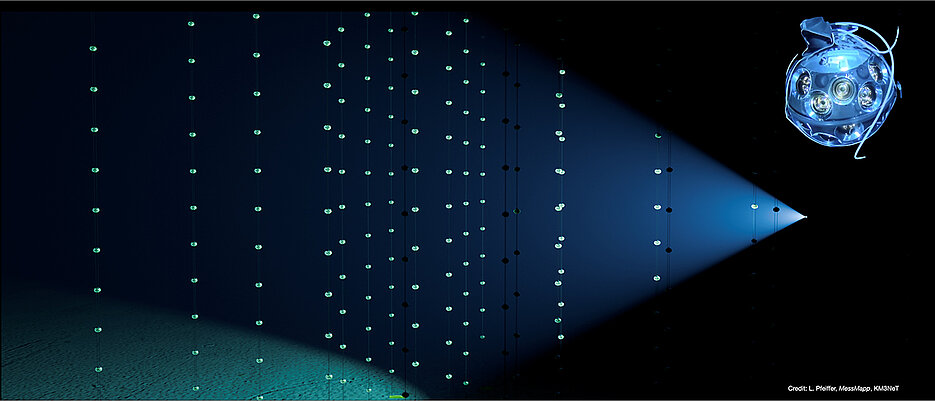An international research network has observed a cosmic neutrino with a record-breaking energy in the depths of the Mediterranean. Würzburg astrophysicist Sara Buson and her team were also involved.

From the abyss of the Mediterranean Sea, scientists including astrophysicists from the Chair for Astronomy in Würzburg, Germany, used the KM3NeT neutrino telescope to detect a cosmic neutrino with a record-breaking energy of about 220 PeV. The ARCA detector, part of the KM3NeT deep-sea observatory, captured this extraordinary event, named KM3-230213A, which is the most energetic neutrino ever observed.
This discovery provides the first evidence that neutrinos of such extreme energies are produced in the universe, a breakthrough now published in today’s issue of the journalNature.
After meticulous analysis and interpretation of the experimental data, the international scientific collaboration working with the kilometre-cubic KM3NeT neutrino telescope has identified a signal on 13 February 2023 with an energy 16,000 times greater than the most powerful particle collisions that can be produced by CERN’s Large Hadron Collider.
The detector picked up a single muon that crossed the entire detector, triggering signals in more than a third of the active sensors. The direction in which it travelled and its strength suggest that the muon came from a cosmic neutrino close to the detector. Neutrinos are the second most abundant particles in the Universe after photons (light). Because they interact very weakly with matter, detecting them requires huge volume instruments.
A huge deep-sea telescope
The KM3NeT telescope, which is currently being built, is a huge deep-sea structure made up of two parts, ARCA and ORCA. At its completion, KM3NeT will be more than one cubic kilometre in size. KM3NeT relies on seawater as both a detection medium and a shield against background noise. Its high-tech optical modules detect the Cherenkov light, a bluish glow that is generated during the movement of the extremely fast particles produced in interactions of neutrinos through the water.
The high-energy universe is full of dramatic events – supermassive black holes, supernova explosions, and gamma-ray bursts – whose inner workings remain largely mysterious. These powerful cosmic accelerators produce streams of cosmic rays, some of which interact with surrounding matter or photons to generate neutrinos and high-energy photons. Others may collide with photons from the cosmic microwave background, creating extremely energetic cosmogenic neutrinos.
Exploring previously uncharted energy ranges
KM3NeT is now detecting neutrinos from extreme astrophysical events, exploring previously uncharted energy ranges. “This first detection of a neutrino in the hundreds of PeV range opens a new chapter in neutrino astronomy,” says Paschal Coyle, KM3NeT spokesperson at the time of the detection and a researcher at IN2P3/CNRS in France. One petaelectronvolt (PeV) corresponds to 1015 or one quadrillion electronvolts.
Neutrinos are among the most mysterious elementary particles – they have no electric charge, almost no mass, and interact only weakly with matter. “They are special cosmic messengers that reveal the secrets of the most energetic phenomena in the universe,” adds Rosa Coniglione, deputy spokesperson for KM3NeT at the time of the discovery and a researcher at INFN in Italy.
Determining the direction and energy of this neutrino required precise calibration of the telescope and advanced track reconstruction algorithms. “This remarkable detection was achieved with only a tenth of the final detector configuration, demonstrating the great potential of our experiment,” comments Aart Heijboer, KM3NeT physics and software manager at the time of the detection and a researcher at the ³Ô¹ÏÍøÕ¾ Institute for Subatomic Physics (Nikhef) in the Netherlands.
“The KM3NeT project is an enormous detector, covering about one cubic kilometer and using around 200,000 photomultipliers,” says Miles Lindsey Clark, KM3NeT Technical Project Manager at the time of detection and research engineer at IN2P3/CNRS in France. “Today’s achievement reflects the tremendous collaborative effort of engineers, technicians, and scientists working in one of the most challenging environments for neutrino research.”
The origin remains a mystery
The origin of the breaking-records neutrino remains an open question. It may originate directly from a powerful extragalactic cosmic accelerator. “Prime candidates are blazars, active galactic nuclei powered by supermassive black holes that emit much more radiation than their entire galaxy. Alternatively, the energetic signal could be the first detection of a cosmogenic neutrino,” says Professor Sara Buson, leader of the ERC-funded MessMapp project at the University of Würzburg (JMU) and DESY, and a collaborator on this work – “The ERC project MessMapp aims to unravel the connection between neutrinos and blazars combining multi-messenger observations. “
A study led by the MessMapp team and collaborators, that appeared today in arXiv, explores the blazar origin of the energetic KM3NeT neutrino. “It required a notable effort in the coordination of international teams of scientists,” says Dr. Massimiliano Lincetto, postdoc in the MessMapp group.
“We utilized a vast amount of observations throughout the whole electromagnetic spectrum, available from the archives and performed new observations with ground- and space-based facilities”, says Leonard Pfeiffer, PhD student in the MessMapp group – including the NASA Fermi Large Area Telescope and Neil Gehrels Swift Observatory. The outcomes of this study reveal a sample of seventeen blazars as possible astrophysical counterparts of the UHE neutrino. Among them, three stand out for their electromagnetic properties. At the neutrino arrival time, one candidate counterpart exhibits a radio flare, another object displays a gamma-ray flare, another object exhibits enhanced X-ray emission.
KM3NeT: a key player in multi-messenger astronomy
While none of these astrophysical sources can conclusively be linked to the UHE neutrino, planned upgrades of the KM3NeT detector and calibration are expected to significantly improve the neutrino localisation, and reduce degeneracy in association. To learn more, astronomers and physicists need to detect more such events. The KM3NeT project is expanding with additional detection units and increased data collection, enhancing its capability to detect cosmic neutrinos and making it a key player in multi-messenger astronomy.
“The origin and mechanisms behind these extremely energetic neutrinos – almost massless and electrically neutral particles – remain a profound mystery in our universe. Our team will continue leveraging multi-messenger astronomy, which is key to solving this puzzle,” concludes Prof. Buson.
Publication
The KM3Net Collaboration: Observation of an Ultra-High-Energy Cosmic Neutrino with KM3NeT, The KM3NeT collaboration, Nature, February 12, 2025, https://www.nature.com/articles/s41586-024-08543-1
Characterising Candidate Blazar Counterparts of the Ultra-High-Energy Event KM3-230213A Observed by KM3NeT. The KM3NeT collaboration, February 12, 2025, Open Access, ArXiv : xxxxxxx
Funding
The European Research Council has funded the described work within the framework of a Starting Grant, PI Sara Buson. ID: 949555, “Mapping Highly-Energetic Messengers across the Universe” (MessMapp).






